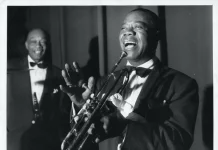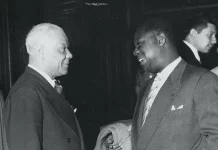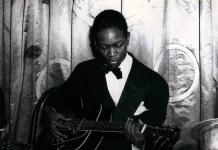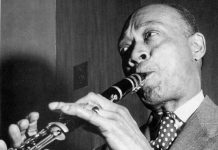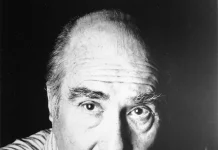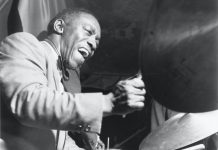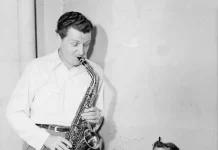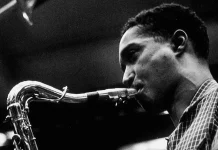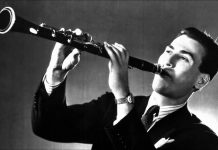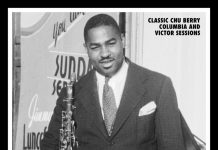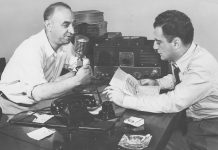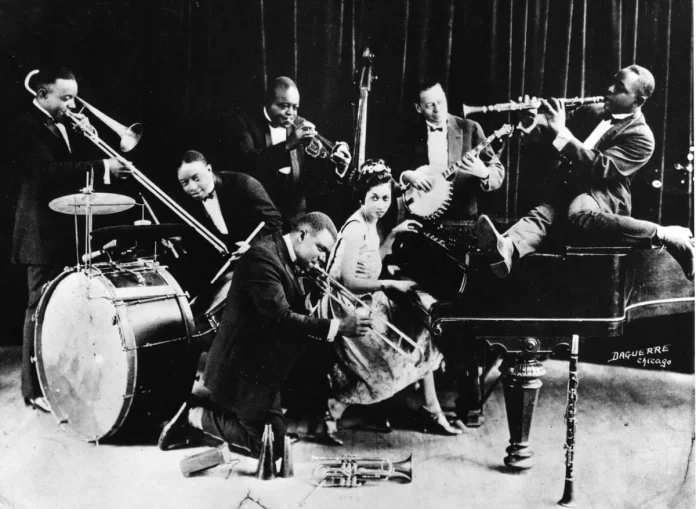
Record collectors have, for a lifetime, regarded Louis Armstrong’s Hot Five and Seven recordings of the 20s as his best work. If one locks oneself into that period it is indeed true that Hotter Than That, Potato Head Blues, Savoy Blues, Muggles and West End Blues seem to be light years ahead of almost everything else recorded by other musicians in that decade.
It is, however, a horrible truth that over the years Louis and his work have persistently been devalued and that we now have a generation a high percentage of whom have never heard of Louis or experienced any of his music. This is a powerful symptom of a huge tragedy. One has to distinguish rigidly between fashion and history in any art. There is no doubt doubt that jazz of any kind has gone out of fashion and even the history of the music that was so generally known years ago has been cast aside by all but those who are encapsulated by age. So it is only in a specialised magazine like this one that it’s appropriate to consider the great changes in Louis’s work as he evolved.
Beginning in April 1923, Armstrong made just about 40 78s with King Oliver’s band. Having built a formidable reputation amongst musicians, he began to be noticed by the general public in 1924 onwards after his first appearances with the Fletcher Henderson band, a recording session backing Ma Rainey and his established role in the Clarence Williams Blue Five. In January 1925, Louis first met Bessie Smith and recorded the first of his great classics with her. This was the first of his multiple accompaniments of Bessie and many of the lesser blues singers of the time.
The original Hot Five with Johnny Dodds made its first recordings on 12 November that year. This was a studio group that appeared only once in public. Louis continued to record with it until 13 December 1927. The latter was the date that produced Savoy Blues, with Lonnie Johnson added to the band. That was the end of what we can describe as the Hot Five with Johnny Dodds. The Hot Five with Earl Hines began on 27 June 1928 but subsequently consistently added extra saxophones. But its quintet recordings produced West End Blues. This track ranked with Savoy Blues and the titles mentioned above as amongst Armstrong’s most sublime works.
Starting with the Olivers and up to West End Blues was a period of just over five years. It was packed with masterworks and there are many reasons for confirming Louis’s genius from that output alone. It used to be the prevailing thought that those five years were the greatest of his career, and indeed, considering the limitless outpouring of dazzling music largely uninfluenced by anyone else, they were wonderful.
There are rumblings amongst some collectors that the Hot Five/Seven masterpieces were not necessarily any greater than Louis’s great recordings from later periods. (Their commercial success was not necessarily any indicator of value to jazz, and thus it is all right for us not to like Hello Dolly and Wonderful World).
But, having established himself as out of reach of the rest of the field, Louis did not stay still. He developed and broadened his style and settings immensely. And that’s where the real controversy began. The Okeh sides from the 20s with larger groups were unfavourably compared with the Hot Fives and Hot Sevens for the same label and with their Lil’s Hot Shots spin-offs. This is quite wrong and unfair.
Some of the bigger combinations – at random, Some Of These Days or Ain’t Misbehavin’ – are as rewarding as any of his work at this period.
It could be said that the birth of the first Louis Armstrong all stars was due to Eddie Condon. March 5, 1929 was one of the busiest days in Louis’s career up to then. Condon had persuaded Tommy Rockwell to record Louis on that day when the trumpeter was in New York to play a one-nighter and to first make records with the Luis Russell band. Rockwell postponed Russell’s date to the afternoon and in the morning recorded Louis with Teagarden, Joe Sullivan, Eddie Lang, Happy Cauldwell and Kaiser Marshall. The sublime Knockin’ A Jug was the result.
Louis always seemed relaxed and happy when Jack Teagarden was working with him. Jack was born in Vernon, Texas on 20 August 1905 and his comparatively short life ended while he was out on tour, having arrived in New Orleans. He was found dead, probably from a heart attack, on the floor of his hotel room on 15 January 1964. He was 58.
Meanwhile the afternoon of 5 March continued without a drop in level as Louis and the Russell band took up their original date.
Louis and Tea must have played together before, but this day was the first occasion in a recording pairing that was to last for the next 40 years, ending at Newport on 6 July 1958. The success of the day was continued in the afternoon session when Louis and the Russell band recorded Can’t Give You Anything But Love and what was to become a statuesque Armstrong classic, Mahogany Hall Stomp.
Is it possible that some collectors regarded these tracks as a decline from the trumpeter’s earlier work? Louis was about to start his next decade by concentrating on pop songs of the day, laying emphasis on both vocal and instrumental work. In 1929, in a move that took him away from regular small groups for more than a decade, he fronted the Carroll Dickerson band. He did the same with the Luis Russell band for six months in 1930. As the 30s went on he grew in stature and reached a worldwide public. He became a film star.
Because of his new prosperity he was leaned on by gangsters for protection money. His answer was to move to Europe in 1933, staying there for two and a half years. Eager to please British audiences, he was reckless with his embouchure and eventually, in autumn 1934, with lips badly distorted, stayed in Paris on an extended holiday to give them a rest. After more work when his mouth recovered, he returned to the States on 24 January 1935. Complications in his life during the spring and summer of that year – the gangsters hadn’t given up – prevented him fronting, as had been planned, the Chick Webb band.
Nonetheless, the arrival of another of his outstanding periods of greatness coincided with the signing of his contract with Decca, for whom he began recording in New York on 3 October 1935. (If you can find one, the entire output of Armstrong’s Decca career between 1935 and 1946 is contained on a seven-CD Mosaic box on MD7-243). His focus on popular songs of the day reminds us that few adages are as true as “They don’t write them like that any more.” The quality of those Deccas throughout the second half of the 30s ranks highly in the trumpeter’s achievements.
After he returned from Europe to the States, Louis later fronted for five years (1937-42) the exciting Luis Russell band that included Red Allen, J C Higginbotham and Pops Foster.
The birth of the permanent Louis Armstrong All Stars was a bit of a murky business. It has been suggested that the idea was taken from his appearance and recordings with the Edmond Hall Sextet in February 1947. Not so. Producer Ernie Anderson had long wished to remove Louis from leading his big band and instead place him with a six-piece. In April 1946 the big band brought about Louis’s return to Broadway. “The greatest jazzman of them all, Louis Armstrong, was back on Broadway . . . Satchmo arrived with one of the biggest (19 pieces), brassiest, and worst bands he ever had, a kind of unintentional satire on everything wrong with big bands,” said one review.
Later in the year the film New Orleans came out of Hollywood. Recorded in September and October, it was typical of the appalling dross of the time, but made notable by the music provided by Louis’s seven-piece, Billie Holiday, Woody Herman and Meade Luxe Lewis. It was the seven-piece, which included Barney Bigard and Kid Ory, that showed how suited the form was to Armstrong. But Louis had had big band backing since the late 20s and his manager Joe Glaser, who had almost total power over Louis, had no plans for a change. Although Glaser had a dubious background, Louis was happy with their relationship. When friends suggested that Glaser was not giving Louis enough of Louis’s own earnings, Louis replied “Did you ever see me look as though i didn’t have the money to pay for anything?”
Out of the usual run of things, Louis had played half a concert with the Edmond Hall sextet (over the years Ed was to remain the most outstanding of Louis’s clarinettists). That evening Armstrong played on a horn borrowed from Bobby Hackett, for Louis’s had been stolen the day before. The concert was at tea-time on 8 February 1947 at Carnegie Hall.
Ernie Anderson and Bobby Hackett approached Louis with the idea for him to lead a small group in another concert. Louis was keen on the idea, but not without Glaser’s approval. Knowing that in Glaser’s case money talked, Anderson dropped a cheque for $1,000 into Glaser’s office. He explained that it was for Louis for one concert without the big band (Louis and the big band together were usually booked for not much more than half that or frequently for even less). Glaser agreed, and Anderson booked the New York City Town Hall for 17 May.
- See part two of Steve Voce’s survey of Armstrong’s all-star bands – looking in depth at the New York City Town Hall concert of May 1947
- See part three of Steve Voce’s survey of Armstrong’s all-star bands – the role of Ed Hall, Jack Teagarden, Earl Hines and others

